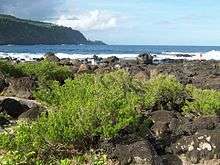Pemphis acidula
| Pemphis acidula | |
|---|---|
 | |
| Pemphis acidula bushes on the shore of Réunion Island | |
| Scientific classification | |
| Kingdom: | Plantae |
| (unranked): | Angiosperms |
| (unranked): | Eudicots |
| (unranked): | Rosids |
| Order: | Myrtales |
| Family: | Lythraceae |
| Genus: | Pemphis |
| Species: | P. acidula |
| Binomial name | |
| Pemphis acidula J.R.Forst & G.Forst | |
| Synonyms | |
Pemphis acidula is a species of flowering plant in the family Lythraceae. The genus Pemphis, to which it belongs, was recently thought have only this single species, first described in 1775 and long considered the type species,[2] but is now believed to have at least one other.[3]
Distribution and habitat
Pemphis acidula is a halophyte bush found in coastal locations in the tropical areas of the Indo-Pacific. It is one of the types of shrubs growing in sandy and calcareous soils of the littoral zones of the Indian Ocean and the western and central Pacific Ocean. It is also found in mangroves.[4]
Uses
The wood of this species has been traditionally valued in many cultures for it is hard and heavy, as well as resistant to rot and warping. It also has naturally a fine finish and may be fashioned into walking canes, fence posts, tool handles, and even anchors.[5] In Réunion and Mauritius it is known as bois matelot[6] In the Maldives this hardy wood was used in traditional shipbuilding to hold the planks of the hull together, as well as to fashion "nails" in local sorcery.[7]
Pemphis acidula is also one of the plant species used in bonsai, particularly in Asia.[8]
Leaves, flowers and fruits
Pemphis acidula bushes behind a dry grass field in Europa Island. |
.jpg) Pemphis acidula flowers and fruits in Aitutaki, Cook Islands. |
 Closeup of flowers and young leaves; Tonga. |
See also
References
- ↑ IUCN Red List of Threatened Species
- ↑ Char. Gen. Pl. 34. 1775 "Plant Name Details for Pemphis acidula". IPNI. Retrieved November 21, 2009.
- ↑ "TPL, treatment of Pemphis". The Plant List; Version 1. (published on the internet). Royal Botanic Gardens, Kew and Missouri Botanical Garden. 2010. Retrieved 26 August 2013.
- ↑ Piggott, C.J. (1961). "Notes on Some of the Seychelles Islands, Indian Ocean" (PDF). Atoll Research Bulletin. 83: 1–10. doi:10.5479/si.00775630.83.1.
- ↑ Wim Giesen; Stephan Wulffraat; Max Zieren; Liesbeth Scholten (2006). "Part 2: Description - Trees & shrubs". Mangrove Guidebook for Southeast Asia. Bangkok, Thailand: FAO, Regional Office for Asia and the Pacific; Wetlands International. ISBN 974-7946-85-8. Retrieved November 21, 2009.
- ↑ xycol.net Pemphis acidula J.R. Forst., 1775 - Nom pilote : miki miki
- ↑ Xavier Romero-Frias, The Maldive Islanders, A Study of the Popular Culture of an Ancient Ocean Kingdom. NEI (1999), ISBN 84-7254-801-5
- ↑ Cheng Cheng-Kung (2007). "Pemphis acidula — A Tropical Classic" (PDF). Bonsai Societies of Florida Magazine. Cooper City, Florida: Bonsai Societies of Florida (BSF). XXXVIII; No. 4 (152 (Winter edition)).
External links
 Media related to Pemphis acidula at Wikimedia Commons
Media related to Pemphis acidula at Wikimedia Commons
